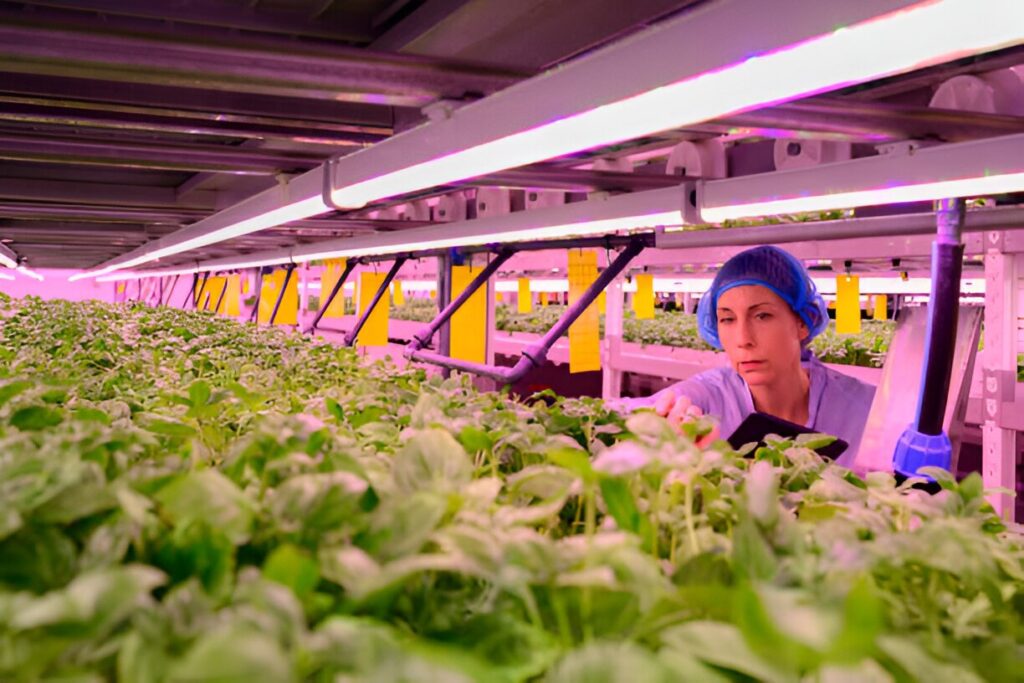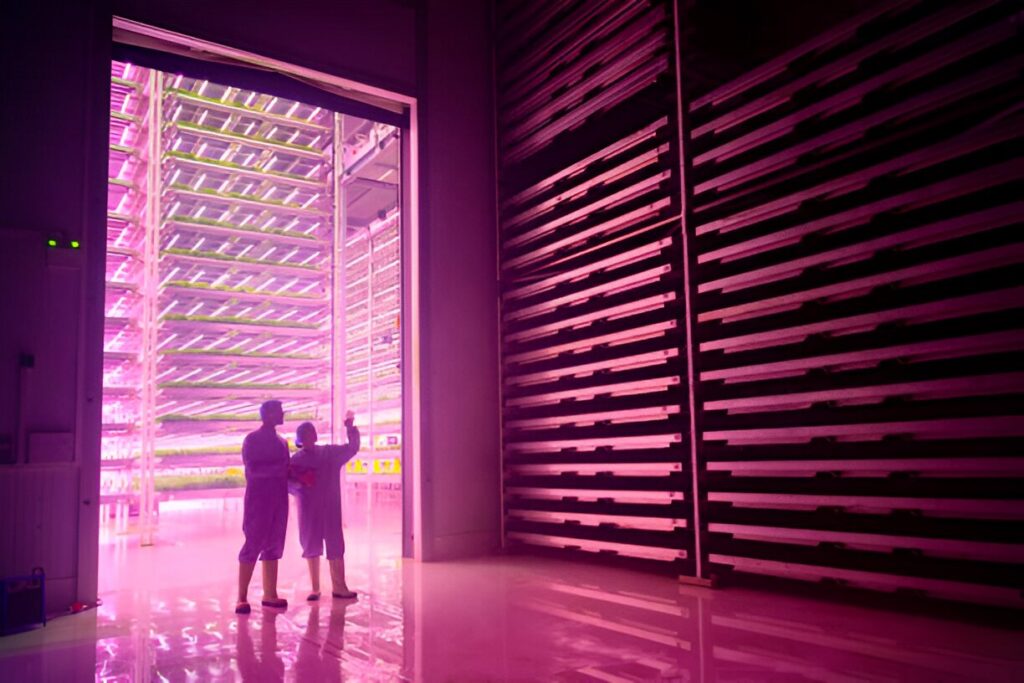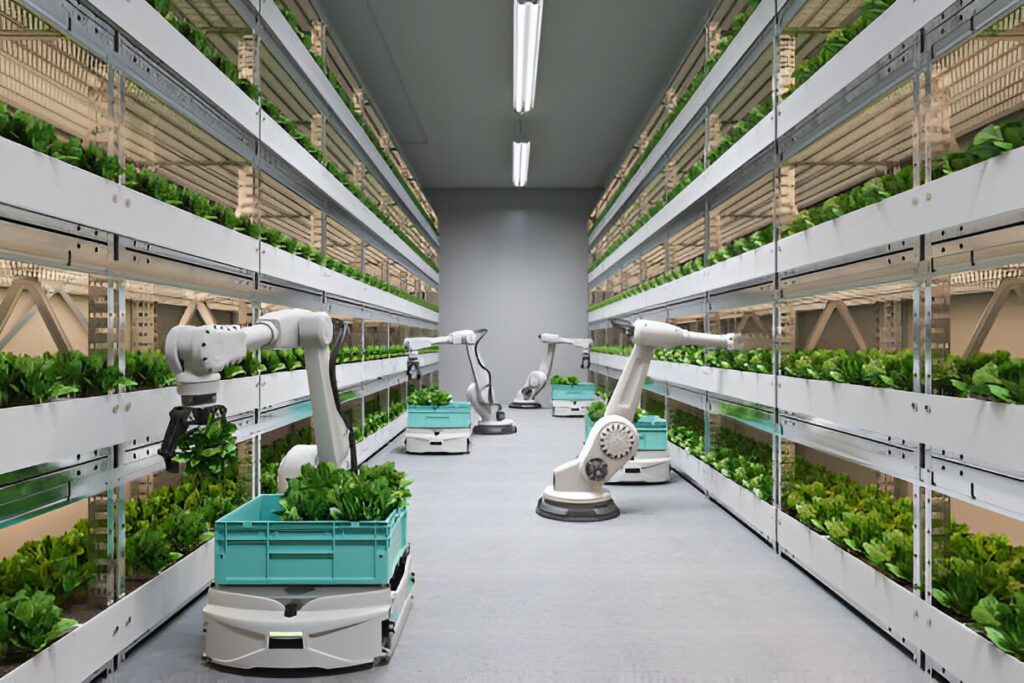Indoor farming, also known as Controlled Environment Agriculture (CEA), involves growing crops in a controlled environment such as a greenhouse or warehouse. This farming approach presents numerous benefits compared to conventional outdoor farming methods. These advantages include decreased susceptibility to severe weather and pests and the capacity to cultivate food closer to urban areas. This proximity reduces both transportation expenses and carbon emissions.

1. Benefits of Indoor Farming
1.1 Sustainable Use of Resources
One of the most significant benefits of indoor farming is its efficient use of resources. Traditional agriculture uses large amounts of water, land, and energy, contributing to greenhouse gas emissions and environmental degradation. Indoor farming can use up to 95% less water and land compared to traditional methods. This dramatic reduction in resource use is good for the planet and ensures that these resources are available for future generations.
Moreover, by optimizing space through vertical stacking and utilizing controlled-environment agriculture (CEA), indoor farms can produce more food per square foot than open-field agriculture. This hyper-efficient use of space is critical in urban settings where land is scarce and expensive. It also opens up the possibility of repurposing disused structures like warehouses and factories into productive agricultural spaces, further reducing the need for deforestation and habitat destruction.
1.2 Year-Round Production
One of the most significant advantages of indoor farming is its ability to produce crops year-round. With traditional agriculture, crops are typically only grown during certain seasons, which can limit production and availability. However, indoor farming can grow crops in a controlled environment regardless of the weather or season, resulting in a consistent and reliable fresh produce supply. This meets consumer demand for fresh produce throughout the year, stabilizes market prices, and reduces the need for imports.
1.3 Increased Efficiency
Indoor farming also offers increased efficiency compared to traditional farming methods. By utilizing modern technology, such as hydroponics and vertical farming systems, indoor farms can produce higher yields in a smaller space. This allows for more efficient use of land and resources, making it a more sustainable option for agriculture. Moreover, recycling water and nutrients within these systems further enhances their efficiency, minimizing waste and reducing the environmental footprint.
1.4 Reduced Environmental Impact

Traditional farming methods can significantly impact the environment through pesticides, water consumption, and greenhouse gas emissions. On the other hand, indoor farming uses less water and eliminates the need for pesticides, resulting in a more environmentally friendly approach to agriculture. Additionally, the controlled environment of indoor farms reduces the risk of contamination and disease, reducing the need for antibiotics and other harmful chemicals. Furthermore, the proximity of indoor farms to urban centers can significantly reduce the carbon emissions associated with long-distance produce transportation.
2. Potential Impact on Food Deserts
Food deserts refer to geographic regions with limited accessibility to fresh, nutritious, and reasonably priced food options for residents. These areas are often in low-income urban and rural communities with no supermarkets or grocery stores within a reasonable distance. Indoor farming has the potential to have a significant impact on food deserts. Using controlled environments and vertical farming techniques, crops can be grown in urban areas close to the communities that need them most. This means that residents in food deserts can access fresh, healthy food, contributing to better nutrition and improved health outcomes.
Additionally, indoor farms in these areas can stimulate local economies by creating jobs and encouraging related businesses to develop. The accessibility of fresh produce can also promote healthier eating habits, which is essential in communities suffering from high obesity and diet-related diseases. By addressing the availability and affordability of nutritious food, indoor farming can play a crucial role in transforming food deserts into wellness oases.
3. Innovations in Indoor Farming
The advancements in modern technology have contributed significantly to the growth and success of indoor farming. Here are some of the most innovative technologies used in indoor agriculture today, from advanced climate control systems to cutting-edge lighting solutions that mimic the full spectrum of sunlight.
3.1 Hydroponics

Hydroponics employs a nutrient-rich water solution as a medium for plant growth, eliminating the need for soil. This technology allows crops to be grown in a controlled environment, using only a fraction of the water and land required for traditional farming. Additionally, hydroponic systems can be automated, reducing the need for manual labor and making the process more efficient. The precision of nutrient delivery in hydroponics also ensures that plants get exactly what they need for optimal growth, which can lead to healthier and faster-growing crops.
3.2 Vertical Farming

Vertical farming involves stacking layers of crops in a vertical tower, utilizing space more efficiently and increasing yields. This method also allows for precise control of light, temperature, and nutrients, resulting in healthier and more consistent crops. With LED lighting, vertical farming can also reduce energy consumption, making it a more sustainable option for indoor agriculture. The vertical design is particularly beneficial in urban areas, where limited space allows for high-density production to support local communities with fresh produce.
3.3 Automation and Artificial Intelligence
The integration of automation and artificial intelligence (AI) in indoor farming is transforming the industry. Automated systems can regulate and oversee the cultivation environment, adapting conditions to ensure the best possible growth for plants. AI can analyze sensor data and make real-time adjustments, resulting in higher yields and reduced labor costs. Machine learning algorithms are becoming increasingly sophisticated, enabling predictive analytics to forecast plant health issues before they become problematic, ensuring consistently high-quality yields.
4. The Potential of Indoor Shrimp Farming
While indoor farming is most commonly associated with crop cultivation, it also has the potential to revolutionize the aquaculture industry. Indoor shrimp farming presents innovative benefits for future agriculture.

4.1 Sustainable Shrimp Production
Traditionally, shrimp farming has harmed the environment due to the use of antibiotics, pesticides and the destruction of natural habitats. Indoor shrimp farming, however, eliminates these issues by providing a controlled environment that reduces the risk of disease and contamination. With sustainable feed and precise water management, indoor shrimp farming can also significantly reduce the environmental impact of shrimp production. Moreover, the closed-loop systems used in indoor shrimp farming prevent waste discharge into natural water bodies, a common problem with traditional shrimp farming methods.
4.2 Higher Quality Shrimp
Indoor shrimp farming also allows for better control over the quality and taste of the shrimp. Traditional shrimp farming exposes them to fluctuating water conditions, impacting their flavor and texture. However, it raises shrimp in a controlled environment, producing consistently high-quality and delicious shrimp. This level of control also allows for the production of organic shrimp, free from contaminants and harmful substances, catering to the growing consumer demand for organic seafood.
4.3 Scalable Business Model
Indoor shrimp farming also offers a scalable business model that can be adapted to meet the demands of the market. By utilizing modular systems and automation technology, indoor shrimp farms can quickly expand and increase production as needed. This makes it a viable option for both small and large-scale operations. The ability to replicate the indoor shrimp farming model in various locations also gives entrepreneurs and investors the flexibility. It includes establishing farms in areas with high demand, optimizing logistics and reducing the carbon footprint associated with seafood transportation.
5. The Future of Agriculture is Here

With the ever-growing demand for food, the agricultural industry is pressured to find more efficient and sustainable ways to produce crops. Indoor farming offers a solution to this challenge with innovative technologies and benefits. Indoor farming, with modern methods, can shape agriculture’s future, ensuring sustainability and a reliable food supply.
iFarm is an innovative approach to farming that leverages advanced technologies such as artificial intelligence (AI), machine learning, and robotics to create highly efficient indoor farming systems. These systems are designed to optimize the growing environment for various crops, including vegetables, herbs, and even fish and seafood.
6. Conclusion
The future of agriculture is constantly evolving, and indoor farming is leading the way in driving this evolution. Indoor farming offers year-round production, efficiency, and environmental benefits, promising solutions to agricultural challenges. Whether it’s crop cultivation or aquaculture, indoor farming offers innovative technologies and a scalable business model that has the potential to revolutionize the way we produce food.
For further exploration of topics related to agriculture, click here.

